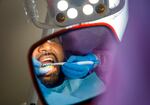
Omar Solano of Beaverton gets dental care tips during a visit to the SmileCare Everywhere Mobile Dental Clinic in Beaverton, April 1, 2021. Students and faculty from Pacific University provide dental hygiene services to underserved and underinsured communities.
Kristyna Wentz-Graff / OPB
During a recent mobile dental clinic, a big RV parked outside St. Cecelia’s Church in Beaverton offered $20 cleanings by student hygienists at Pacific University.
Gabriela, a 47-year-old mother of two who asked that OPB not use her last name because she is undocumented, was thrilled with the service for her family. But she faced a problem: Years of delayed care meant she remained in excruciating pain, especially when eating.
“I think the pain goes to your spine cord because the pain goes to your whole body when the fork touches the teeth that is broken or the teeth that needs the root canal,” she said. “That pain usually gets me for an hour … it’s not a pain that goes away easily.”
Hygienists cleaned Gabriela’s teeth, but they couldn’t do anything more than that for her. They’re not dentists, so hygienists can only do preventive care. Dental hygienists require two years of post-secondary education, as opposed to the eight years required to become a dentist.
House Bill 2528 would create a third kind of dental license — a dental therapist — that would require more training than hygienists, but less than dentists. A therapist would be required to get three years of training and could do basic dental procedures such as filling cavities and simple extractions, under the supervision of a dentist.
The goal is to reduce the cost of care and improve access, especially in rural areas where dentists are sometimes scarce. Oregon has the full-time equivalent of 0.49 dentists per 1,000 people, according to a 2019 report by the Oregon Office of Rural Health.
Thousands of Oregonians can’t get regular dental care. As a result, 30 percent of older Oregonians have lost six teeth or more. And bad teeth can have serious repercussions: If you can’t chew healthy fibrous food, you’re more likely to eat soft, less nutritious food. Children in pain can’t sleep and fall behind at school.
“We found that it affects people’s ability to get a job, because if you don’t have that winning smile, it’s really hard to feel confident in an interview, and it’s hard to get past those interviews,” said Dr. Miranda Davis, a dentist at the Northwest Portland Area Indian Health Board.
A wide range of Oregon health care and dental care organizations, children’s groups, educators, Tribes and other organizations support the bill.

Gabriela talks with her daughter after receiving dental care from Pacific University students and faculty.
Kristyna Wentz-Graff / OPB
Ten years ago, staff at the Northwest Portland Area Indian Health Board began researching possible solutions to a lack of adequate dental care. They found states such as Minnesota and Alaska licensing new types of dental therapists.
The idea was floated in the Oregon Legislature as early as 2011, but it couldn’t get traction. In 2016, state lawmakers decided that Oregon Health Authority should study the idea.
That happens a lot in the Legislature. If someone is pushing against an idea — and they don’t have the votes to kill it — they push a plan to a study.
So pilot projects No. 100 and No. 300 are underway. Several therapists have been trained and are working successfully under supervision. But they keep having to prove their benefit again and again, said Amy Coplen, director of the Pacific University School of Dental Hygiene.
“Every tooth has to get several photos taken of it. Every procedure has multiple aspects that needed to be reported to the Oregon Health Authority,” Coplen said. “The pilots have been an enormous administrative burden, to prove things that have already been proven, honestly.”

"The pilot (projects) have been an enormous administrative burden, to prove things that have already been proven honestly,” said Amy Coplen, director of the Pacific University School of Dental Hygiene.
Kristian Foden-Vencil / OPB
More than 1 million Oregonians live in areas with a shortage of dentists. About 24 primary care service areas in rural Oregon — areas sometimes covering hundreds of square miles — have no full-time dentist at all.
The primary opposition to the dental therapist bill comes from the Oregon Dental Association, which represents and lobbies on behalf of about 2,000 dentists. The bill would take some dental procedures and give them to therapists, although the ODA says it’s not opposed to the concept of dental therapy. They just think therapists need more education, tighter oversight and a smaller scope of practice than required by this bill.
Take, for example, a dental therapist in Joseph, who potentially could do a simple tooth extraction with the oversight of a dentist in Portland. Even though many of us have wiggled a loose tooth free, a simple extraction can turn complex quickly, says Dr. Caroline Zeller, a Portland dentist. For example, if a patient starts bleeding profusely or a tooth ends up needing to be cut away, a dental therapist might need more immediate help than a dentist who isn’t in the same office can provide.
“Before starting a procedure, a provider should have the ability to manage the treatment and complications of that procedure,” Zeller said.
In this extraction scenario, the therapist could be a six-hour drive away from the overseeing dentist.
The dentist’s association also notes that people in the more vulnerable populations that could be served by dental therapists are also more likely to suffer complications with their teeth.
“When a tooth becomes difficult to remove, it is most certainly surgery,” Zeller said. “It is the most stressful procedure done in a dental office on awake patients. And when we talk about vulnerable populations, we are talking about some of the most complicated health histories. Removing a tooth on these individuals is riskier than those that are healthy.”
She said more complicated procedures require treatment from an individual with more training, not less.
“Providers should have sufficient training so that they aren’t simply robots. ... They should be trained to understand the disease processes, the anatomy and physiology of their patients,” she said. “But if the goal is simply to create technicians that focus more on using their hands than understanding why, then the level of supervision and scope of practice should reflect that
“Either provide sufficient training to set them up for success or protect them by increasing their level of supervision and decreasing their scope of practice.”
Amendments that would address specifics such as how much training therapists would receive, their scope of their responsibilities and what oversight would be required have been proposed by state Rep. Tawna Sanchez, a Portland Democrat and the primary sponsor of the bill. The trouble, she says, is that each new requirement reduces the practicality of dental therapists.
Requiring a therapist working in rural Oregon to serve with an on-site dentist, for example, makes the whole idea prohibitively expensive. There aren’t enough dentists already.
“We’ve been trying to compromise, maybe not doing the best job sometimes, and I will admit to being a tad cranky about it now and then,” Sanchez said. “But … I think that we should be committed to making sure that we have appropriate health care for people in the state of Oregon.
“COVID-19 has impacted access to health care and dental care for Oregonians throughout the state. But for many Oregonians, that inability to get basic dental care for themselves and their families existed before COVID — and will exist afterward.”

Pacific University students and faculty provide dental hygiene services aboard the SmileCare Everywhere Mobile Dental Clinic in Beaverton, April 1, 2021. Left to right: Wilber Ramirez-Rodriguez, patient Omar Solano, and students Maria Guerrero and Ariana Trevino.
Kristyna Wentz-Graff / OPB
Back in the church parking lot, Gabriela’s 15-year-old daughter emerged from the dental clinic with a brightened smile. But Gabriela knows she’s unlikely to save the thousands of dollars needed to fix her own teeth. Instead, she calls dental schools in search of an appointment. It’s a long shot.
Even House Bill 2528 wouldn’t be much help to her now, since her teeth are too far gone. But it might have helped a few years ago by making it easier for her to catch problems before they got so bad.
Health experts have been trying to license dental therapists for 10 years now. The latest bill sits in the House Committee on Health Care. To stand a chance, it must be voted out of committee by Tuesday, April 13.
